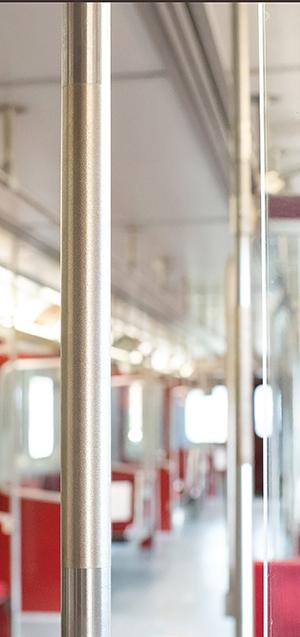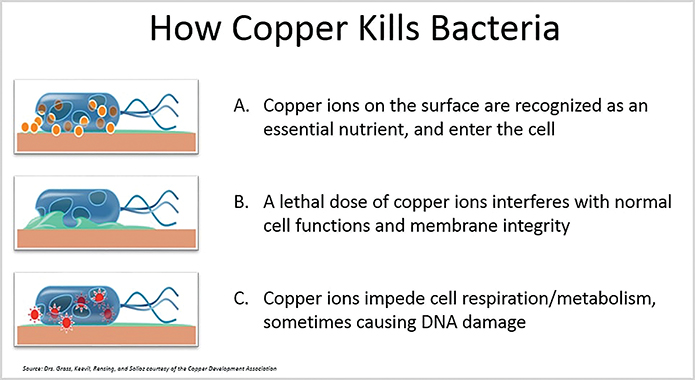
With a plethora of disinfecting and antimicrobial solutions entering the transit marketplace in the wake of COVID-19, a time-tested technology is reemerging for agencies looking to restore faith in public transportation – antimicrobial copper.
Aereus Technologies partnered with Olin Brass to produce and distribute the CuVerro Shield™, a solution of antimicrobial copper alloy which kills 99.9 percent of bacteria upon contact. In addition to the solution’s utility in the healthcare, education, and hospitality markets, Aereus representatives see the CuVerro Shield making a major impact on transit buses, stations, and trains.
“The recent pandemic has caused an increase in the use of sanitizing products on buses and in everyday life,” said Terry Frank, executive vice president of sales and marketing for Aereus Technologies. “In some cases, sanitizing agents are damaging transit vehicles as well as exposing riders to potentially harmful chemicals. Antimicrobial copper is naturally recyclable, non-chemical, non-consumable, and generally is not found to be harmful to humans or causing allergic reactions.”
“Importantly for electric vehicles (EVs) in transit,” he added, “is that antimicrobial copper adds almost no weight, and its one-time application is permanent for the life of a vehicle.”

Aereus Technologies started in 2014 with an emphasis on studying copper ions as a biocide (a substance intended to kill or control harmful organisms), but the company quickly migrated toward studying how copper might be used to fight superbugs (antibiotic-resistant bacteria) in the healthcare industry.
Many studies have successfully shown that copper ions are highly effective at killing many superbugs. From that knowledge base, Aereus developed proprietary techniques to deploy a solid layer of copper on surfaces in a permanent, low-cost, and aesthetically pleasing way.

Aereus partnered with Olin Brass, the manufacturer of CuVerro Shield alloys. CuVerro® was already the first solid surface material to be granted “antimicrobial public health claims” status by the U.S. Environmental Protection Agency (EPA) and was also approved to make public health claims with the Pest Management Regulatory Agency (PMRA) in Canada. Aereus incorporated its technologies to deploy Olin’s registered alloy. This partnership opened the door for CuVerro deployment on projects previously thought too expensive for the registered copper alloys, including the public transportation sector.
“Our CuVerro Shield process allows us to apply a 150-micron solid functional layer of antimicrobial copper alloy to any existing part – plastic or metal – thereby reducing the operating costs significantly from prior generations,” Frank said.
How Antimicrobial Copper Works
When a bacteria cell meets with a copper surface, the bacterium recognizes copper ions as an essential nutrient, permitting the ions to enter the cell. This ruptures the bacteria cell’s outer membrane and interferes with its normal functions, causing cell death.
Furthermore, the copper ions impede the bacteria cell’s cell respiration/metabolism. This can oftentimes cause irreparable DNA damage to the cell, making it unlikely for the bacteria will develop any future resistance to the alloy.
Moving to Transit
Aereus connected with MS Transit Solutions (MSTS), a consulting and representation firm for the mass transit industry.
MSTS specializes in Buy America manufacturing consulting, sales and marketing representation, proposal preparation, and strategic marketing services and planning for companies considering entry into the mass transit market. For some companies, MSTS provides general engineering services consulting, project and program planning and implementation, project management, and legacy product sourcing.
“Aereus had clearly done their homework in developing antimicrobial-copper-based stanchion/handrail coverings,” said David Barrett, strategic consultant for MSTS. “This product was tested, certified, and ready for market.”
With MSTS’s help, agencies around the United States began reviewing antimicrobial copper stanchions for their own operations.
“We are finding acceptance in transit based on word-of-mouth,” said Mike Slugocki, president of MSTS. “When agencies see that a functional layer of copper can be applied to stanchions, seat handles, and other high-touch surfaces on a vehicle, they see that it can be a gamechanger. The copper is always functioning and working, whether or not someone touches it.”

The solution’s lightweight application can be a major benefit for an industry focused on weight related to vehicle efficiency, Slugocki said.
“If you are buying a new bus and applying a functional copper layer to its stanchions, it only adds 12 grams per linear foot of weight – or about 6.5 pounds to the weight of a new bus,” he said. “It automatically translates to less fuel consumption, less tire wear, and longer-lasting vehicles. Further, recent testing has shown that Kydex® Thermoplastic resin can be used to make retrofittable two-piece stanchion covers with a CuVerro Shield solid surface. Tests have shown that this combination of engineered materials showed compliance to CMVSS/FMVSS and Docket 90A ASTM 162 and ASTM662, FRA & NFPA 130.”
Testing for Transit
The CuVerro Shield (along with two other copper-based products) participated in a pilot study designed by local health and transit agencies, and sponsored by Teck Resources Limited (Teck), exploring the feasibility of antimicrobial copper in public transportation.
Teck is one of Canada’s leading mining companies, with operations in Chile, United States, and Peru as well. Teck is a significant copper producer, along with other metals, and is set to become one of the world’s major producers of copper when its Quebrada Blanca Phase 2 Project in Chile comes on line in 2022.
In November 2020, Teck partnered with TransLink (the transit agency serving Vancouver, B.C.), Vancouver Coastal Health (VCH), VGH & UBC Hospital Foundation, Coalition for Healthcare Acquired Infection Reduction Canada, and the University of British Columbia to test antimicrobial copper coatings on high-touch transit surfaces on buses and SkyTrains in Vancouver. This project, fully funded by Teck, was the first of its kind in North America.
“There is no commercial benefit for Teck from the increased use of antimicrobial copper, because the amount of metal used in these applications is minuscule compared to our overall production,” said Catherine Adair, manager of community development for Teck. “The Copper & Health program is part of our Corporate Social Responsibility program – with a goal of using copper to improve the health and safety for our communities. It also raises awareness about the role that mining and metals play in our everyday lives.”
Adair said that the testing phase on TransLink buses and trains showed that copper can kill up to 99.9 percent of bacteria on transit surfaces, which confirms the registrations by PMRA in Canada and the EPA in U.S.
After these promising results from the test pilot, Teck expanded the project to include the Toronto Transit Commission (TTC). As in Vancouver, the trial is testing three types of Health Canada registered products including CuVerro Shield, and will be conducting laboratory testing on copper’s ability to kill viruses in addition to bacteria.

Copper products were installed on buses, subway cars, and streetcars in the Greater Toronto Area, as well as more locations on Vancouver buses and SkyTrains. Samples are analyzed from copper surfaces as well as non-copper surfaces on transit by VCH’s medical microbiology team, supported by Mount Sinai Hospital/University Health Network in Toronto and the University of British Columbia in Vancouver. Researchers from the University of British Columbia will also test and analyze the durability of the three products as they age over the course of the year.
“The antimicrobial capacity of copper is already proven, with Health Canada and EPA registrations, as well as over 200 published peer-reviewed studies affirming its effectiveness,” Adair said. “These transit authorities are really testing the cost, durability, and feasibility of application – everything an agency needs to know to make investment decisions in health and safety.”
The full results of the test pilots will be available in late 2022. Frank and Adair both said they are extremely encouraged by early findings.
Partnership with Vicinity Motor Corp.
Aereus recently partnered with Vicinity Motor Corp. (VMC) a leading supplier of electric, CNG, gas, and clean diesel vehicles. Beginning late last year, VMC began offering CuVerro Shield as an optional feature on all Vicinity™ Classic and Lightning™ EV buses.
John LaGourgue, vice president, corporate development, director, said VMC and Aereus Technologies were introduced through a common shareholder.
“I was really attracted to the opportunity to provide more safety in the marketplace,” he said. “We are interested in pursuing anything we can do to make bus travel safer. This is an easy solution for our customers since a retrofit does not require removing or replacing an entire stanchion.”
Frank said that VMC, a major EV manufacturer, was a natural fit for CuVerro Shield.
“It does not add any significant weight to the vehicle, which
is very valuable because of the industry-wide push toward EVs,” he said. “In addition to the greater mileage capacity, the CuVerro Shield represents no increase in operating costs. Its one-time, lightweight application lasts the life of a vehicle – which should be even longer now thanks to less wear on tires, brakes, and other components.”
In addition to its being an option on new vehicles, CuVerro Shield is also available for retrofit application for all current operating fleets of Vicinity buses throughout North America.
Spreading the Word
Frank said that agencies are “delightfully surprised” at the efficacy and low costs associated with antimicrobial copper, and he is hopeful that its use will spread rapidly among transit systems in North America.
“Compared to what agencies are going through today with sanitizers and disinfection, the incremental costs of antimicrobial copper is a radical improvement,” he said. “And when the pandemic is over – and provided agencies keep surfaces clean and free of debris – these antimicrobial copper surfaces will continue to function for the life of a vehicle.”
In emerging news, the EPA has already approved (EPA Reg. # 82012-1) Group 1 copper alloys for having supplemental residual efficacy claims against SARS-CoV-2 (COVID-19) and testing submittals continue for antimicrobial copper Groups 2-5.
